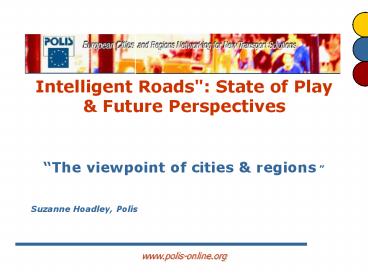Intelligent Roads": State of Play - PowerPoint PPT Presentation
1 / 17
Title:
Intelligent Roads": State of Play
Description:
Most cities and towns are equipped with UTC systems. Why? ... Eg, London' electronic purse (Oyster card) contactless card holding season ... – PowerPoint PPT presentation
Number of Views:38
Avg rating:3.0/5.0
Title: Intelligent Roads": State of Play
1
Intelligent Roads" State of Play Future
Perspectives
- The viewpoint of cities regions
- Suzanne Hoadley, Polis
2
Main ITS applications in cities/regions
- Traffic management
- Most cities and towns are equipped with UTC
systems - Why?
- To best manage different users of road space
(pedestrians, cyclist, drivers and public
transport) main difference between highway and
urban road network - To optimise traffic flow at all times
- Traffic control centres
- Integrated UTC centres, eg, Berlin (PT road
operators under one roof). - Other stakeholders and services, eg, transport
police in London (incident management), observing
public disorder (Birmingham)
3
Main ITS applications in cities/regions
- Traffic management
- Data gathering
- Sources local and highway authorities, transport
police, automobile clubs, buses/trams, events, - Technologies CCTV, loops, eye in the sky,
floating vehicle data (eg, Surrey CC) - Delivery mechanisms transport authority alone or
public-private partnerships, eg, VMZ Berlin,
4
Main ITS applications in cities/regions
- Demand management strategies
- Approaches
- Road pricing/tolling, eg, London, Trondheim
- Access restrictions, eg, Rome
- Similar policy objectives (reduce congestion in
city centre) but different methods - Technologies from simple (ANPR) to sophisticated
(GPS) - London Rome ANPR
- Why? simple, proven technology
- Accuracy 90 London 98 Rome
- London trials of tag beacon medium-term
objective differentiated pricing (GPS)
5
Some intelligent users reactions
Alcune reazioni
6
Main ITS applications in cities/regions
- Demand management strategies
- Wider developments
- Locally
- More and more cities considering road pricing
and/or access restrictions as a tool to combat
congestion - European level
- Infrastructure charging directive
- Interoperability directive
- (subsidiarity interuban network only but apply
defacto to cities) - National initiatives
- Germany and UK national lorry road user charging
7
Main ITS applications in cities/regions
- Real-time network information
- Road network
- Interfaces VMS, Internet, SMS, on-board
- Real-time but also working on predictive
information - Reroute journey or choose alternative travel mode
- Parking information guidance
- Information on parking space availability (VMS)
- Route guidance
- Prebooking services (Internet)
8
Main ITS applications in cities/regions
- Real-time Public Transport (PT) information
priority - Interfaces PT stops (LCD displays, Göteborg),
Internet, public screens/kiosks (eg, Bristol
shopping centre hospital), SMS (eg, Hellobus,
Bologna) - PT priority at signals and bus-lane enforcement
- Technology AVL (GPS or sensors) CCTV
9
Main ITS applications in cities/regions
- Smartcards
- Aims to facilite PT use and intermodality
- Eg, London electronic purse (Oyster card)
contactless card holding season passes and pay as
you go - Multifunctional Smartcards
- to pay for other transport services (eg, tolls)
- Extend to other services, eg, bankcard, municipal
services (library card, etc)
10
Main ITS applications in cities/regions
- Improving safety
- Incident detection and management
- Speed and red-light camera enforcement
- Improving environment
- Monitoring of air quality and adapting traffic
management strategy accordingly (HEAVEN project) - Journey planning
- Few (if any) offer real-time journey planning but
working towards it
11
Main challenges
- Legacy systems
- Difficult to retrofit ITS applications to bespoke
or older UTC systems, eg, Paris bus priority - Integration
- Problem systems from different suppliers can
rarely talk to eachother - Solutions common/open platforms (eg, UTMC,
DATEX, etc protocols but not yet standards)
12
Main challenges
- Funding
- Benefits of UTC well established
- Not the case for other ITS applications
- Main issue WHO SHOULD PAY?
- Authorities, industry or public?
- CBA should consider impact of ITS on broader
transport policy objectives, eg - contribution to modal shift (RT PT information,
bus priority, journey planners, road network
information) - reduced congestion (road network information)
- air quality improvements, eg, HEAVEN DSS
- Potential solution PPP, eg, MATTISSEM3
13
Future perspectives
- Cooperative vehicle infrastructure systems (CVIS)
- Local authority perspective potentially huge
benefits but long-term vision (20 years) - Early examples, Intelligent Speed Adaptation
(ISA) - Wider security benefits
- Remotely stopping a vehicle instead of dangerous
police pursuit - Current ANPR technology can reveal unlicensed,
uninsured vehicles - Main concerns
- Car manufacturers imposing technology on
infrastructure operators - Liability who responsible if technology fails?
14
Future perspectives
- Benefits of GPS/Galileo for cities/regions
- Managing municipal fleets
- Improve reliability of real-time PT information
- Less infrastructure intensive for bus priority
- Urban road pricing
- Fairer system of charging (according to time,
distance and journey) - Incident detection managment
15
What is Polis ?
- A network of cities and regions working in the
field of transport - 70 members
- Partnerships with research centres and industry
- founded in 1989
- President AMT Genoa (Italy)
- based in Brussels with a staff of 7
- Aim to promote innovation in transport both at
technical and organisational level, through - learning from one other (sharing experiences
solutions) - implementing innovative solutions (promoting
innovative solutions and facilitating access to
EU RTD projects) - promoting sustainable mobility (voice of cities
and regions vis-à-vis European ins
16
Polis in support of ITS
- ITS is a core activity of Polis
- Many members previously currently involved in
EU-funded RTD projects in field of ITS - Current priorities
- Promote take-up of ITS solutions
- Faciliate exchange of experiences
- Current activities
- Traffic efficiency WG
- Aims to learn from best practice, develop a
vision for the future, dialogue with the
Commission on perpsectives for cities (CVIS, etc)
and support required
17
- Thank you
- For more information
- shoadley_at_polis-online.org
- www.polis-online.org































